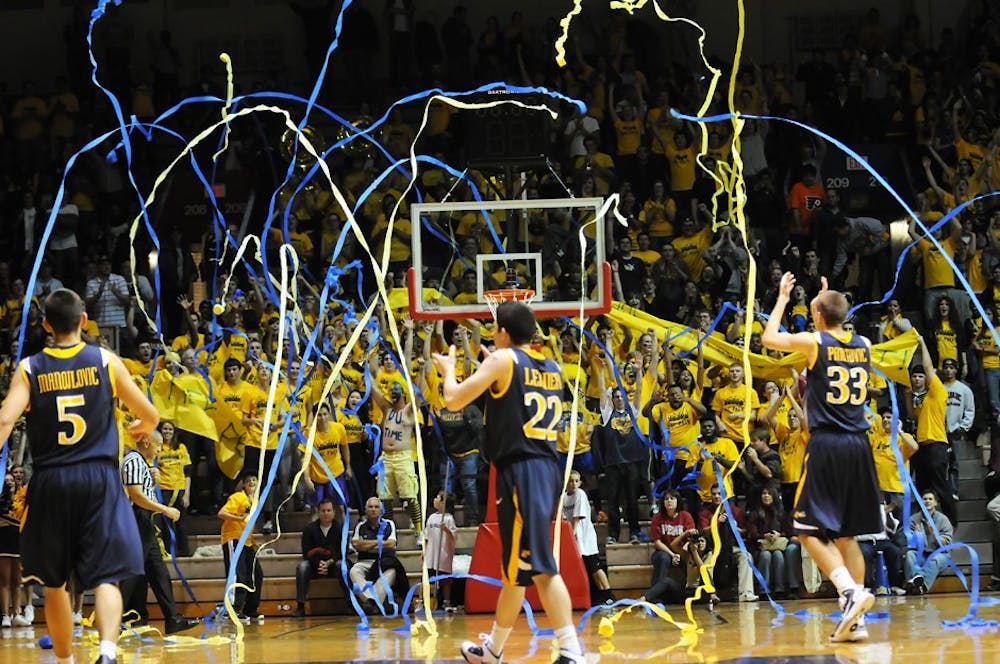
It was a scene that made the Penn basketball historians cringe. After more than two decades, throwing streamers had returned to the Palestra for the 2010 season. But instead of Red and Blue crepe paper flying through the baking gymnasium air, it was Blue and Gold. Drexel.
The Dragons, in the third game of the season, beat the Quakers, 77-56. It was the men’s hoops team’s fourth straight loss to Drexel.
Since the two teams began playing regularly in 1997, the series stands even at 8-7. But despite Drexel’s recent run, a healthy rivalry had sprung up between the West Philly neighbors. In fact, the 2010 tilt saw the highest attendance for the Penn-Drexel game in the last decade. It even developed a nice little name: The Battle for 33rd Street.
Though Drexel isn’t an official member of the Big 5, it is still a city game — a University City game, at that — and there is always pride on the line.
But this year, pride will have to wait. For the first time since 1997, there was no neighborhood matchup.
“We tried hard,” Penn coach Jerome Allen said of an attempt to schedule the matchup this year. “[We] kept trying to bang dates out and they had a tough early schedule, obviously we had a tough schedule with the Hoop Group [Classic], and it just didn’t happen.”
Allen added that his staff is working hard with Drexel coach Bruiser Flint and his team to make sure the game happens again next season.
“I think it’s great for the city — Bruiser’s a Philly guy, I’m a Philly guy. They have a number of guys on their team from the area,” Allen said.
“It’s something that should be played. We’re both right here.”
But as the two programs look to schedule future meetings, half the battle may be deciding where exactly the Battle for 33rd Street is fought.
With the Palestra so close to both teams, it’s hard not to use what many call the best college basketball arena in the country.
For Drexel, though, there’s the issue of fairness and homecourt advantage. It may only be a few city blocks from the Dragon’s Daskalakis Center, but the Red and Blue split-P at center court of the Palestra traditionally confers some sort of benefit to the Quakers. And then there’s the fact that Colonial Athletic Association teams, Drexel included, often have trouble scheduling non-conference home games.
For each of the past two years, Drexel has only hosted four of 11 non-conference games.
Flint was unavailable for comment as the Dragons were on the road this week visiting CAA foe William & Mary.
Would the Quakers mind heading north, if only a few blocks, to play on Drexel’s turf?
“I would love to see all of the city games played here like it once was,” Allen said before a practice at the Palestra.
“I’ll take the games whether they’re played here or not, as long as we still have some resemblance of a City series.”
Senior Zack Rosen said with all the pick-up games between players of both teams in the off-season, he’d also like to get an official game each. His classmate Rob Belcore agreed.
“I think it’s really important that this game is played in the Palestra,” Belcore said. “I know Drexel wants us to come play there, but honestly when you see the Palestra packed half gold, half blue, it’s pretty sweet.”
Nonetheless, the Palestra has been the traditional venue for the West Philadelphia rivalry; only once in 18 games (dating back to 1923) was the game held on Drexel’s court.
“My take, and the people I’ve talked to at Drexel over the years, is that it makes all the sense in the world to have it in the Palestra on an annual basis,” Penn Director of Athletics Steve Bilsky said.
“The basketball people might look at it as a disadvantage. But when you look at it institutionally, by playing it in the Palestra, both teams’ sets of fans can come every year with some sense of balance in the arena,” he added.
Should the rivalry be restarted next season, as many in the Penn program hope it will, Bilsky said he would like to see the arena arrangement between the two teams eventually grow to the point where it matches that of Penn-St, Joseph’s.
Under the current scheme, which will end this year due to the Hawks’ changing priorities, Penn and St. Joe’s play at the Palestra each year, splitting the 8,000 seats in half, diagonally. The teams alternate which is home and away, and arrangements such as broadcasting rights would be the responsibility of the home team.
“If you played it in a smaller arena, you would be basically disenfranchising our group.”
The Daskalakis Athletic Center seats over 2,300. Average attendance at the last five Penn-Drexel games was 5,109, a figure pulled down by the one game played at Drexel in 2008 — a capacity crowd.
The Daily Pennsylvanian is an independent, student-run newspaper. Please consider making a donation to support the coverage that shapes the University. Your generosity ensures a future of strong journalism at Penn.
DonatePlease note All comments are eligible for publication in The Daily Pennsylvanian.





